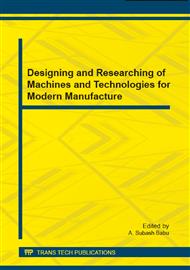p.180
p.186
p.190
p.196
p.200
p.205
p.210
p.215
p.219
The Modeling and Performance Analysis of the Three Degrees Spring-Mass System
Abstract:
The paper uses modern control theory and mechanical and structural vibration theory to study a mass-spring system of three degrees. Using Newton's first law analyzing the force of the object, drawn the simulation diagram from the control perspective. Reflecting all changes of the independent variables and their relationships. And revealing the characteristics of the system. We also analyzed the system can not only be controlled but also can be observed, understanding the inherent nature of the system further. About the dynamic characteristics of the system, we use the main formation method to calculate the natural frequency, the main formation and displacement response of the system[1].
Info:
Periodical:
Pages:
200-204
Citation:
Online since:
December 2014
Authors:
Price:
Сopyright:
© 2015 Trans Tech Publications Ltd. All Rights Reserved
Share:
Citation:


